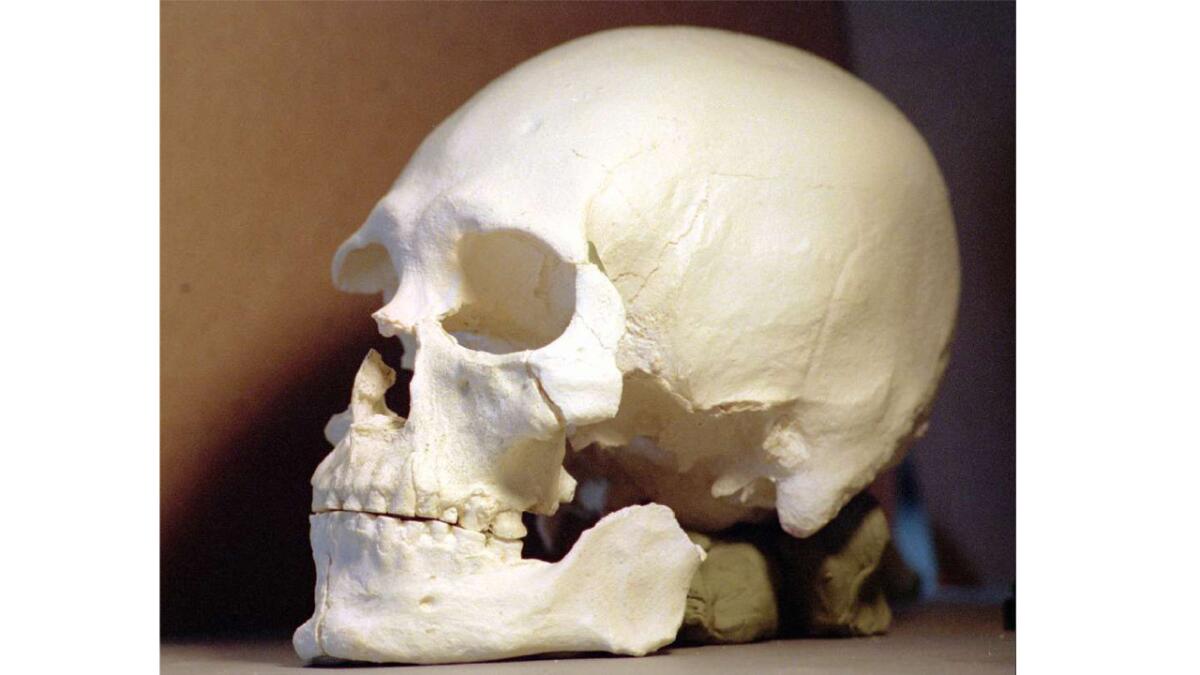Kennewick Man’s DNA reveals he was a Native American, study says

This plastic casting shows a controversial 9,200–year–old skull that belonged to Kennewick Man. New DNA analysis backs claims from tribes in the Northwest that he was a Native American.
- Share via
In an ironic twist, an analysis of ancient DNA from the specimen known as Kennewick Man supports the claims of Native Americans that he is their long-lost relative.
After comparing short genetic sequences from the skeleton’s hand to the corresponding DNA from people alive today, scientists concluded that Kennewick Man “shares by far the most with other Native Americans,” said Stanford University geneticist Morten Rasmussen, who participated in the analysis.
The finding, reported Thursday in the journal Nature, opens a new chapter in the 19-year saga of the specimen. The nearly complete skeleton was discovered in 1996 at the bottom of the Columbia River in Kennewick, Wash., near the Oregon border.
At the time, scientists were eager to study the 8,500-year-old specimen to learn more about the origins of early Americans.
But Native Americans in the Northwest opposed the research on cultural and religious grounds. So they tried to block it, citing a 1990 law that required Native American remains and artifacts found on federal lands to be returned to their tribes.
Scientists challenged the tribes’ claim on the skeleton in court, arguing that features of the man’s skull more closely resembled those found in people from Japan and Polynesia than those of modern Native Americans. The tribes ultimately lost the dispute in 2004 after nearly a decade of legal wrangling.
Nobody owns the remains, but they are controlled by the U.S. Army Corps of Engineers. They wound up in the custody of the Burke Museum of Natural History and Culture in Seattle.
Research has continued on the bones. Studies of the cranium have continued to conclude that Kennewick Man came from a different population than the ancestors of Native Americans.
DNA could offer a more definitive answer. As long ago as the 1990s, scientists had tried but failed to examine the DNA of Kennewick Man, also known as the Ancient One.
They were able to pull off the feat now, Rasmussen said, because of recent improvements in genetic sequencing technology that make it possible — and affordable — to study DNA from ancient specimens, which often are badly degraded.
Once Kennewick Man’s DNA was extracted from a tiny piece of bone, scientists compared it with DNA from people from Europe, Asia and the Americas — including two members of the Colville tribe in Washington state, one of the groups that had claimed the remains.
The researchers tested whether the Colville tribe members might have been direct descendants of the population to which Kennewick Man belonged. The data suggested three possible scenarios: that they were direct descendants, with some outside genes contributed when ancestors mated with different groups; that they and Kennewick Man shared an earlier common ancestor who lived about 9,200 years ago; or a combination of both.
Rasmussen’s team also revisited — and rejected — the conclusions of the earlier research on skull shape. Though Kennewick Man’s narrow cranium did not resemble the head of today’s Native Americans, it could have been in the normal range among those who lived thousands of years ago.
Harvard Medical School geneticist and ancient DNA expert David Reich, who was not involved in the research, called the new paper exciting and impressive.
“It shows convincingly that Kennewick is a member of the same broad population as most present-day Native Americans,” he said.
What helped make the study so convincing was the fact that Native Americans donated their DNA for comparison with the ancient sample.
Reich said he hoped more Native American groups would do the same in the future, because their genetic information would help scientists more clearly understand how ancient Native Americans relate to present-day tribes.
On Thursday, representatives from some of the tribes that were involved in the battle over Kennewick Man’s remains said that although they were delighted with the study’s results, they would not contribute DNA for future research.
The scientists have “proven something that we as people have always known, through our history and our traditions and culture,” said Ruth Jim of the Bands of the Yakama Nation. “I don’t think we have to submit to DNA testing to prove who we are.”
The representatives said they had renewed hope that they could reclaim the Ancient One for burial.
Assessing the new science and figuring out whether the remains might legally be returned to the tribes will take time, said Brig. Gen. John Kem, commander of the corps’ Northwest division.
“We won’t rush this,” he said, noting that the last court battle over the skeleton had been expensive for his agency and, by extension, U.S. taxpayers.
Kem said that he met with the scientists and tribal representatives this week and that he had been excited to see the results.
The process of figuring out how the new information will affect Kennewick Man’s future was already underway, he said.
Study senior author Eske Willerslev, an evolutionary biologist at the University of Copenhagen’s Center for GeoGenetics, deflected questions about how the new findings would affect the repatriation battles.
“We’re just scientists putting out the result of our analysis — that’s it,” he said.
READ MORE
Kennewick Man: Scientists unravel 9,300-year-old skeleton’s past
9,300-Year-Old Bones Declared Indian Remains
Kennewick Man Still Has a Lot to Say
Follow me on Twitter @LATerynbrown and “like” Los Angeles Times Science & Health on Facebook.





